How long is a Year on other Planets?
One day is the time it takes a planet to spin around and make one full rotation.
Here on Earth that takes 24 hours. (Because a planet is also moving around the sun, its position is constantly changing. That means this is not exactly the same as the time it takes to go from one sunrise to the next.)
But how long are days on other planets in our solar system?
Day Length
- Mercury 1,408 hours
- Venus 5,832 hours
- Earth 24 hours
- Mars 25 hours
- Jupiter 10 hours
- Saturn 11 hours
- Uranus 17 hours
- Neptune 16 hours
A Year on Mercury
To put it simply, Mercury has an orbital period of 88 days (87.969 to be exact), which means a single year is 88 Earth days – or the equivalent of about 0.241 Earth years.
But here’s the thing. Because of Mercury’s slow rotation (once every 58.646 days) and its rapid orbital speed (47.362 km/s), one day on Mercury actually works out to 175.96 Earth days.
A Year on Venus
The second closest planet to our Sun, Venus completes a single orbit once ever 224.7 days.
This means that a single year on Venus works out to about 0.6152 Earth years.
But, once again, things are complicated by the fact that Venus has an unusual rotation period. In fact, Venus takes 243 Earth days to rotate once on its axis – the slowest rotation of any planet – and its rotation is retrograde to its orbital path.
A Year on Mars
Mars has one of the highest eccentricities of any planet in the Solar System, ranging from 206,700,000 km at perihelion and 249,200,000 km at aphelion. This large variation and its greater distance from the Sun, leads to a rather long year.
Basically, Mars takes the equivalent of 687 days to complete a single orbit around the Sun, which works out to to 1.8809 Earth years.
A Year on Jupiter
Jupiter is another interesting case.
Whereas the gas giant only takes 9 hours 55 minutes and 30 seconds to rotate once on its axis, it also takes alson 11.8618 Earth years to complete an orbit around the Sun.
This means that a year on Jupiter is not only the equivalent of 4,332.59 Earth days, but 10,475.8 Jovian days. That’s a lot of sunrises!
A Year on Saturn
Much like its fellow gas giant Jupiter, Saturn takes it time completing a single orbit of the Sun, but rotates on its axis very rapidly.
All told, a year on the planet lasts the equivalent of 10,759 Earth days (or about 29.122 years). But since it only takes 10 hours, and 33 minutes to complete a single rotation on its axis, a year on Saturn works out to 24,491.07 Saturnian days.
A Year on Uranus
Uranus has some of the strangest annual and seasonal variations of any planet in the Solar System.
For one, the gas/ice giant takes about 84 Earth years (or 30,688.5 Earth days) to rotate once around the Sun. But since the planet takes 17 hours, 14 minutes and 24 seconds to complete a single rotation on its axis, a year on Uranus lasts 42,718 Uranian days.
A Year on Neptune
Given its distance from the Sun, Neptune has the longest orbital period of any planet in the Solar System.
As such, a year on Neptune is the longest of any planet, lasting the equivalent of 164.8 Earth years.
But since Neptune also takes comparatively little time to rotate once on its axis (16 hours, 6 minutes and 36 seconds), a single year lasts a staggering 89,666 Neptunian days.
A Year on Pluto
The dwarf planet remains one of the most fascinating celestial bodies known to astronomers.
In addition to having a very distant orbit around the Sun, it also has the most eccentric orbit of any planet in the Solar System.
This makes for a rather long year on Pluto, which lasts the equivalent of 248 Earth years!
















Lascia un commento
Devi essere connesso per inviare un commento.